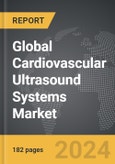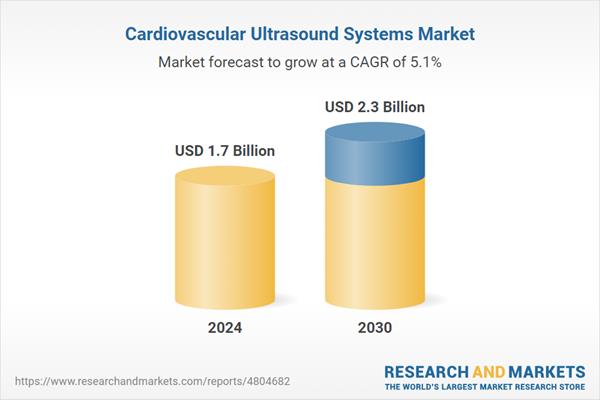The global market for Cardiovascular Ultrasound Systems was valued at US$1.7 Billion in 2024 and is projected to reach US$2.3 Billion by 2030, growing at a CAGR of 5.1% from 2024 to 2030. This comprehensive report provides an in-depth analysis of market trends, drivers, and forecasts, helping you make informed business decisions.
Global Cardiovascular Ultrasound Systems Market - Key Trends and Drivers Summarized
How Are Cardiovascular Ultrasound Systems Revolutionizing Heart Diagnostics?
Cardiovascular ultrasound systems, commonly known as echocardiography systems, are non-invasive diagnostic tools that use high-frequency sound waves to create detailed images of the heart and its surrounding structures. These systems are essential in diagnosing, monitoring, and managing a wide range of cardiovascular conditions, including heart valve disorders, heart failure, congenital heart defects, and coronary artery disease. By generating real-time images of the heart's chambers, valves, and blood flow, cardiovascular ultrasound systems allow physicians to evaluate the heart's function without the need for more invasive procedures, such as catheterization or surgery. The ability to quickly assess heart health and detect abnormalities in real time has made cardiovascular ultrasound a cornerstone of modern cardiology, especially in outpatient, emergency, and perioperative settings. Since these systems use sound waves instead of radiation, they pose no risk to patients, making them suitable for a broad range of populations, including pregnant women and children. Cardiologists rely on these systems to perform various types of echocardiograms, such as transthoracic echocardiograms (TTE), transesophageal echocardiograms (TEE), and stress echocardiograms, each offering unique insights into different aspects of heart function. The non-invasive nature and diagnostic accuracy of cardiovascular ultrasound systems make them indispensable tools for both early diagnosis and long-term management of heart disease.How Have Technological Advances Improved Cardiovascular Ultrasound Systems?
Technological advancements have dramatically transformed cardiovascular ultrasound systems, enhancing their diagnostic capabilities, portability, and ease of use. One of the most significant developments is the introduction of three-dimensional (3D) and four-dimensional (4D) echocardiography, which offers real-time, detailed images of the heart in motion. These technologies provide a more comprehensive view of the heart's structure and function, allowing clinicians to better visualize heart valves, detect abnormalities, and plan complex interventions like valve replacements or repairs. In addition, 3D and 4D imaging can improve surgical outcomes by offering precise images of congenital heart defects or structural heart problems before the procedure even begins. This level of detail was previously unattainable with traditional two-dimensional echocardiography and has significantly improved the accuracy of diagnoses and treatment planning. Another technological leap is the rise of portable and handheld cardiovascular ultrasound systems. These compact devices enable clinicians to perform echocardiograms at a patient's bedside, in the emergency department, or even in remote locations, without the need for large, stationary machines. This portability increases access to critical diagnostic tools, particularly in underserved or rural areas where traditional echocardiography systems may not be available. Additionally, many of the latest ultrasound systems are now equipped with advanced AI and machine learning algorithms that assist in image interpretation and analysis. These AI-enhanced systems can automatically detect and quantify heart abnormalities, significantly reducing the time required for manual analysis and improving diagnostic consistency. Cloud-based connectivity and data-sharing capabilities further enhance the functionality of modern ultrasound systems, allowing for real-time collaboration between healthcare providers and remote specialists, ensuring timely and accurate patient care.What Are the Emerging Trends in Cardiovascular Ultrasound Systems?
Several emerging trends are driving the continued evolution of cardiovascular ultrasound systems, reflecting advancements in medical imaging technology and changing healthcare needs. One major trend is the growing use of point-of-care ultrasound (POCUS) in cardiology, which is reshaping how and where ultrasound examinations are performed. POCUS systems are small, portable devices that allow healthcare providers to perform echocardiograms at the patient's bedside or in outpatient settings. This trend is increasing access to cardiovascular imaging, particularly in emergency settings where rapid diagnosis is critical. It is also extending the use of ultrasound into primary care and general practice, enabling early detection of cardiovascular issues without the need for specialized imaging centers. The integration of artificial intelligence (AI) and machine learning into cardiovascular ultrasound systems is another significant trend. AI is being used to automate various aspects of image acquisition, analysis, and reporting, reducing the dependency on the operator's expertise and minimizing human error. For example, AI algorithms can assist in detecting heart abnormalities, measuring ejection fraction, or tracking heart valve movements with greater precision and speed. These AI-driven features help standardize diagnostic procedures, ensuring that even less experienced operators can produce high-quality results. Another key trend is the increasing use of contrast-enhanced echocardiography, which improves the visibility of cardiac structures, particularly in patients with suboptimal image quality. Contrast agents, injected into the bloodstream, enhance the clarity of the images produced by ultrasound, enabling more accurate assessments of conditions like ischemic heart disease or myocardial infarctions. Finally, the trend toward interoperability is making it easier for cardiovascular ultrasound systems to integrate with broader hospital information systems (HIS) and cardiovascular information systems (CVIS), creating a seamless flow of patient data across different departments and improving care coordination.What Factors Are Fueling the Expansion of the Cardiovascular Ultrasound Systems Market?
The growth in the cardiovascular ultrasound systems market is driven by several factors, primarily linked to advancements in technology, rising healthcare demands, and the evolving needs of healthcare providers. One of the most significant drivers is the increasing global prevalence of cardiovascular diseases, such as heart failure, coronary artery disease, and hypertension. As these conditions continue to rise, the demand for non-invasive, accurate, and cost-effective diagnostic tools like cardiovascular ultrasound systems has surged. Healthcare providers are increasingly relying on these systems to diagnose heart conditions early, monitor disease progression, and evaluate the effectiveness of treatments, all of which contribute to improved patient outcomes. Another major growth driver is the shift towards more portable and point-of-care ultrasound devices, which have expanded the use of echocardiography beyond traditional hospital settings. Portable devices enable healthcare providers to bring diagnostic imaging to patients, particularly in emergency situations or in remote areas, ensuring timely care and reducing the need for expensive and invasive procedures. Technological advancements, such as 3D and 4D imaging, AI integration, and cloud connectivity, have also fueled market growth by improving the functionality, accuracy, and ease of use of these systems. Furthermore, the rising adoption of AI in healthcare is enhancing the diagnostic capabilities of these systems, allowing for faster and more consistent image interpretation. The trend toward value-based care, where the focus is on improving outcomes while controlling costs, has further driven the adoption of cardiovascular ultrasound systems, as they offer a cost-effective, non-invasive alternative to other imaging modalities like CT or MRI. Lastly, growing investments in healthcare infrastructure, particularly in developing regions, are expanding access to advanced ultrasound technologies, further accelerating market growth. As healthcare systems worldwide strive to improve early diagnosis and management of cardiovascular diseases, the demand for cardiovascular ultrasound systems is expected to continue rising.Report Scope
The report analyzes the Cardiovascular Ultrasound Systems market, presented in terms of market value (US$ Thousand). The analysis covers the key segments and geographic regions outlined below.Segments
Test Type (Stress Echocardiogram, Transthoracic Echocardiogram, Transesophageal Echocardiogram, Other Test Types); Technology (2D, 3D & 4D, Doppler Imaging); Device Display (Black & White, Color); End-Use (Hospitals, Diagnostic Centers, Ambulatory Care Centers, Other End-Uses).Geographic Regions/Countries
World; United States; Canada; Japan; China; Europe (France; Germany; Italy; United Kingdom; and Rest of Europe); Asia-Pacific; Rest of World.Key Insights:
- Market Growth: Understand the significant growth trajectory of the Stress Echocardiogram Test segment, which is expected to reach US$1.0 Billion by 2030 with a CAGR of a 6.0%. The Transthoracic Echocardiogram Test segment is also set to grow at 3.9% CAGR over the analysis period.
- Regional Analysis: Gain insights into the U.S. market, valued at $453.5 Million in 2024, and China, forecasted to grow at an impressive 4.8% CAGR to reach $357.6 Million by 2030. Discover growth trends in other key regions, including Japan, Canada, Germany, and the Asia-Pacific.
Report Features:
- Comprehensive Market Data: Independent analysis of annual sales and market forecasts in US$ Million from 2024 to 2030.
- In-Depth Regional Analysis: Detailed insights into key markets, including the U.S., China, Japan, Canada, Europe, Asia-Pacific, Latin America, Middle East, and Africa.
- Company Profiles: Coverage of major players such as Chison Medical Imaging Co., Ltd., Esaote SpA, FUJIFILM Holdings Corporation, GE Healthcare, Hitachi Medical Corporation and more.
- Complimentary Updates: Receive free report updates for one year to keep you informed of the latest market developments.
Why You Should Buy This Report:
- Detailed Market Analysis: Access a thorough analysis of the Global Cardiovascular Ultrasound Systems Market, covering all major geographic regions and market segments.
- Competitive Insights: Get an overview of the competitive landscape, including the market presence of major players across different geographies.
- Future Trends and Drivers: Understand the key trends and drivers shaping the future of the Global Cardiovascular Ultrasound Systems Market.
- Actionable Insights: Benefit from actionable insights that can help you identify new revenue opportunities and make strategic business decisions.
Key Questions Answered:
- How is the Global Cardiovascular Ultrasound Systems Market expected to evolve by 2030?
- What are the main drivers and restraints affecting the market?
- Which market segments will grow the most over the forecast period?
- How will market shares for different regions and segments change by 2030?
- Who are the leading players in the market, and what are their prospects?
Some of the 13 major companies featured in this Cardiovascular Ultrasound Systems market report include:
- Chison Medical Imaging Co., Ltd.
- Esaote SpA
- FUJIFILM Holdings Corporation
- GE Healthcare
- Hitachi Medical Corporation
- Mindray Medical International Ltd.
- Philips Healthcare
- Samsung Electronics Co., Ltd.
- Siemens Healthineers
- Toshiba Medical Systems Corporation
Table of Contents
I. METHODOLOGYII. EXECUTIVE SUMMARY2. FOCUS ON SELECT PLAYERSIII. MARKET ANALYSISCANADAITALYREST OF EUROPEREST OF WORLDIV. COMPETITION
1. MARKET OVERVIEW
3. MARKET TRENDS & DRIVERS
4. GLOBAL MARKET PERSPECTIVE
UNITED STATES
JAPAN
CHINA
EUROPE
FRANCE
GERMANY
UNITED KINGDOM
ASIA-PACIFIC
Companies Mentioned (Partial List)
A selection of companies mentioned in this report includes, but is not limited to:
- Chison Medical Imaging Co., Ltd.
- Esaote SpA
- FUJIFILM Holdings Corporation
- GE Healthcare
- Hitachi Medical Corporation
- Mindray Medical International Ltd.
- Philips Healthcare
- Samsung Electronics Co., Ltd.
- Siemens Healthineers
- Toshiba Medical Systems Corporation
Table Information
| Report Attribute | Details |
|---|---|
| No. of Pages | 182 |
| Published | March 2025 |
| Forecast Period | 2024 - 2030 |
| Estimated Market Value ( USD | $ 1.7 Billion |
| Forecasted Market Value ( USD | $ 2.3 Billion |
| Compound Annual Growth Rate | 5.1% |
| Regions Covered | Global |









